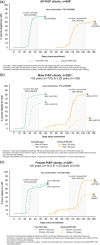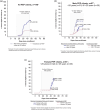A modified pharmacy provider-led delivery model of oral HIV pre- and post-exposure prophylaxis in Kenya: a pilot study extension
- PMID: 40569884
- PMCID: PMC12231645
- DOI: 10.1002/jia2.26467
A modified pharmacy provider-led delivery model of oral HIV pre- and post-exposure prophylaxis in Kenya: a pilot study extension
Abstract
Introduction: Private pharmacies in Africa reach individuals with ongoing and periodic HIV risk, yet few countries currently leverage pharmacies as an HIV service delivery platform. We conducted a 6-month pilot to evaluate a model for pharmacy provider-led delivery of HIV pre- and post-exposure prophylaxis (PrEP and PEP) in Kenya.
Methods: At 12 private pharmacies in Kisumu and Kiambu Counties, licensed pharmacy providers initiated and managed eligible clients ≥18 years on PrEP and PEP under remote clinician supervision (NCT04558554); four of these pharmacies additionally offered sextually transmitted infection (STI) testing. PrEP/PEP clients were scheduled for follow-up 1 month later and then quarterly (PrEP clients only). Primary outcomes included PrEP and PEP initiation and continuation during the pilot period. Client and providers rated the model across multiple constructs of acceptability and feasibility from established frameworks.
Results: From January to July 2022, 1028 clients interested in PrEP, PEP and/or STI testing were screened and 829 initiated one or more service: 661 PrEP, 162 PEP and 52 STI testing. About half of clients (48%, 398/829) were male, most were unmarried (78%, 644/829) and PrEP-naïve (89%, 737/829), and the median age was 25 years (IQR 22-31). Most PrEP clients reported inconsistent condom use (88%, 581/661) or sex with partners of unknown HIV status (70%, 460/661) in the past 6 months. Most PEP clients reported condomless sex (48%, 78/162) or a condom break (46%, 75/162) in the past 72 hours; 4% (6/162) reported sexual assault. Among PrEP clients eligible for a refill, 73% (479/658) refilled at least once and 60% (197/328) twice. Among PEP clients eligible for follow-up, 44% (65/148) completed follow-up HIV testing and 20% (30/148) transitioned to PrEP. Among STI clients, 19% (10/52) tested positive for gonorrhoea (n = 7) and/or chlamydia (n = 5). Most clients and providers (≥92%) found the delivery model and its implementation strategies acceptable. All providers (n = 12) thought it was possible to deliver PrEP and PEP at pharmacies in Kenya.
Conclusions: Pharmacy PrEP/PEP delivery achieved high uptake, continuation and acceptability among eligible clients that could benefit, highlighting the potential of pharmacies to expand HIV prevention service coverage in Kenya, particularly to individuals not accessing these services at clinics.
Keywords: HIV prevention; Kenya; differentiated service delivery; post‐exposure prophylaxis; pre‐exposure prophylaxis; private pharmacies.
© 2025 The Author(s). Journal of the International AIDS Society published by John Wiley & Sons Ltd on behalf of International AIDS Society.
Conflict of interest statement
PM is an employee of Novartis, outside of the present work. KN has received research funding from the Merck Investigators Studies Program. For the remaining authors, none were declared.
Figures



Similar articles
-
Online delivery of oral HIV pre- and post-exposure prophylaxis: findings from the ePrEP Kenya pilot.J Int AIDS Soc. 2025 Jun;28 Suppl 1(Suppl 1):e26468. doi: 10.1002/jia2.26468. J Int AIDS Soc. 2025. PMID: 40569864 Free PMC article. Clinical Trial.
-
Low selection of HIV PrEP refills at private pharmacies among clients who initiated PrEP at public clinics: findings from a mixed-methods study in Kenya.BMC Health Serv Res. 2024 May 11;24(1):618. doi: 10.1186/s12913-024-10995-0. BMC Health Serv Res. 2024. PMID: 38730398 Free PMC article. Clinical Trial.
-
High acceptability, feasibility and sustainability of a direct-to-pharmacy differentiated PrEP delivery model in public health HIV clinics in Kenya: perspectives of PrEP clients and healthcare providers.J Int AIDS Soc. 2025 Jul;28 Suppl 3(Suppl 3):e26442. doi: 10.1002/jia2.26442. J Int AIDS Soc. 2025. PMID: 40622359 Free PMC article.
-
Population-based interventions for reducing sexually transmitted infections, including HIV infection.Cochrane Database Syst Rev. 2004;(2):CD001220. doi: 10.1002/14651858.CD001220.pub2. Cochrane Database Syst Rev. 2004. Update in: Cochrane Database Syst Rev. 2011 Mar 16;(3):CD001220. doi: 10.1002/14651858.CD001220.pub3. PMID: 15106156 Updated.
-
Population-based interventions for reducing sexually transmitted infections, including HIV infection.Cochrane Database Syst Rev. 2001;(2):CD001220. doi: 10.1002/14651858.CD001220. Cochrane Database Syst Rev. 2001. Update in: Cochrane Database Syst Rev. 2004;(2):CD001220. doi: 10.1002/14651858.CD001220.pub2. PMID: 11405980 Updated.
Cited by
-
HIV Post Exposure Prophylaxis: prospects, opportunities and challenges.J Int AIDS Soc. 2025 Jun;28 Suppl 1(Suppl 1):e26511. doi: 10.1002/jia2.26511. J Int AIDS Soc. 2025. PMID: 40569861 Free PMC article. No abstract available.
References
-
- PEPFAR . PEPFAR's Five‐year Strategy: Fulfilling America's Promise to End the HIV/AIDS Pandemic by 2030. Washington, DC: U.S. Department of State; 2022.
-
- Kenya Ministry of Health . National AIDS Control Council. Kenya AIDS Strategic Framework II 2020/21 ‐ 2024/2025. Nairobi: Ministry of Health; 2021.
-
- Kenya Ministry of Health . National AIDS & STI Control Program. Private Sector Engagement Framework for Delivery of HIV Services in Kenya 2023–2028. Nairobi: NASCOP; 2023.
-
- World Health Organization . Updated recommendations on service delivery for the treatment and care of people living with HIV. Geneva: WHO; 2021. - PubMed
-
- Global Fund . HIV Information Note Allocation Period 2023–2025. Geneva: Global Fund; 2022.
Publication types
MeSH terms
Substances
Grants and funding
LinkOut - more resources
Full Text Sources
Medical
Miscellaneous

